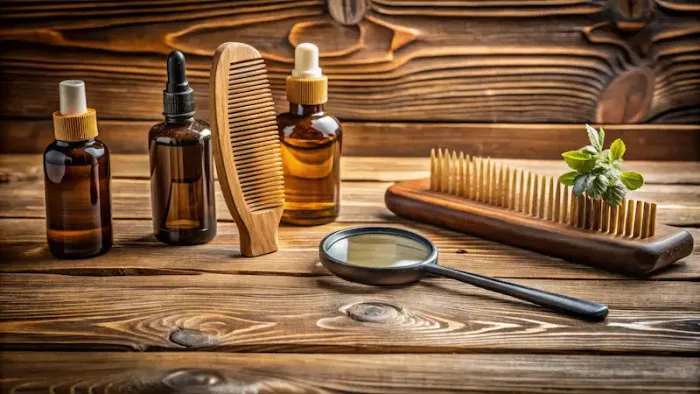Effective Home Remedies to Get Rid of Head Lice
Learn evidence-based home remedies for head lice removal, step-by-step wet-combing, safe cleaning, and hair care tips to prevent re-infestation.


Introduction: Why head lice and home care matter
Head lice are extremely common and are particularly frequent among school-aged children—although adults can get them too. Despite popular myths, head lice are not associated with poor hygiene, dirty homes, or lack of care. They occur simply because lice spread easily in environments where heads are close together, such as playgrounds, schools, sleepovers, and family activities.
When head lice are discovered, it can cause stress or embarrassment, but it doesn’t need to. With calm, consistent steps, most families can successfully treat lice at home. The goal is not only to eliminate the lice but also to interrupt the cycle of re-infestation. This guide focuses on evidence-based home methods, especially wet-combing, which remains one of the most effective approaches. You’ll also learn practical cleaning routines, prevention strategies, and when to reach out to a healthcare professional.
Understanding head lice: what you’re dealing with
Head lice (Pediculus humanus capitis) are tiny insects about the size of a sesame seed. They live close to the scalp because they feed on small amounts of blood several times a day. Their eggs, called nits, are attached firmly to hair strands and are often found behind the ears and at the nape of the neck.
Key facts to remember:
• Lice are common and not a sign of poor hygiene.
• They spread mainly through direct head-to-head contact.
• Lice do not jump or fly; they crawl.
• Pets do not spread lice.
• Lice off the scalp usually survive only 1–2 days.
• Nits need warmth from the scalp to hatch, so environmental spread is low risk.Consult a Top General Practitioner for Personalised Advice
Understanding these facts helps reduce panic and prevents unnecessary cleaning or harsh measures.
The most effective home remedy: wet-combing (no chemicals needed)
Wet-combing remains one of the most reliable non-medication approaches for removing lice. It physically removes live lice and nits and is gentle enough for babies, children, and adults, including people avoiding chemicals.
Wet-combing works best when you are consistent. One thorough session is not enough—the life cycle of lice means you must keep combing over time.
What you’ll need
• A fine-toothed metal lice comb (these work better than plastic).
• Regular conditioner or detangler to lubricate hair.
• Hair clips to divide the hair into sections.
• A bright light to improve visibility.
• Paper towels or a white cloth to check what has been removed.
• Patience and a follow-up schedule.
Step-by-step wet-combing for lice removal
• Wash hair and apply plenty of conditioner.
• Do not rinse the conditioner—it helps immobilise lice.
• Divide the hair into small, manageable sections using clips.
• Place the comb at the scalp and pull it through to the ends in one motion.
• After each stroke, wipe the comb on a paper towel and inspect for lice or nits.
• Focus on the areas where lice commonly hide: behind the ears and at the neckline.
• Rinse out conditioner after combing and do a final check on damp hair.
Tips to improve success
• Work slowly and thoroughly; depending on hair thickness, a session can take 20–60 minutes.
• Use bright lighting or natural sunlight where possible.
• Metal combs tend to catch more nits than plastic combs.
• Repeat wet-combing every 3–4 days for at least 2 weeks.
• Continue until no live lice are found for at least two consecutive sessions.
Conditioner helps with combing but is not a treatment. The success of wet-combing comes from consistent, repeated removal.
Smart home cleaning: simple steps that work
Many families waste time deep-cleaning the entire house. Head lice do not live long away from the scalp, so heavy cleaning is unnecessary. Focus only on items used within the previous 48 hours.
Quick cleaning checklist
• Machine-wash clothing, pillowcases, hats, towels, and bedding used within the last 2 days.
• Use hot water (at least 54°C / 130°F) and a hot dryer cycle.
• Items that cannot be washed (soft toys, cushions, fabric headbands):
o Seal them in a plastic bag for 2 weeks.
• Brushes, combs, and hair accessories:
o Soak in hot water (at least 54°C / 130°F) for 5–10 minutes.
• Surfaces and furniture:
o Vacuum sofas, carpets, and areas where the person rested.
Avoid fumigant sprays or strong cleaning chemicals—these are unnecessary, expensive, and may be harmful.
What about over-the-counter (OTC) treatments?
Some families use OTC lice products along with wet-combing. These products can be useful when applied correctly.
If using an OTC treatment:
• Choose a product specifically labelled for head lice (not body lice).
• Follow the instructions word-for-word—more product does not work better.
• Most treatments require a second application 7–10 days later.
• Even with OTC treatments, removing nits by combing reduces the chance of re-infestation.
If you still see live lice after following instructions exactly, speak with a healthcare provider. In some areas, lice have become less responsive to certain OTC products.
When to call your healthcare provider?
Contact a healthcare professional if:
• Live lice are still seen after correct treatment and thorough wet-combing.
• The person has asthma, eczema, or a sensitive scalp.
• The affected person is pregnant, breastfeeding, or a child under 2 years old.
• The scalp appears infected (increasing redness, pus, or pain).
• You are not sure that what you see is lice or dandruff.
Healthcare providers can prescribe treatments such as spinosad or topical ivermectin, which often require fewer applications.
Myths and what not to do
There is a lot of misleading advice online, and some “home remedies” can be dangerous.
Avoid the following:
• Suffocation methods (petroleum jelly, mayonnaise, oils):
o They are messy and do not consistently kill eggs.
• Essential oils:
o Not regulated, may cause allergic reactions or skin irritation.
• Vinegar or harsh chemicals:
o Not proven and can cause burns or scalp irritation.
• Hair dye or bleach:
o Not reliable; lice can survive the process.
• Pesticide sprays or foggers for the house:
o Unnecessary and can expose families to chemicals.
• Petroleum, kerosene, or flammable liquids:
o Never use these—they are extremely dangerous.
Sticking to proven methods saves time and avoids risk.
Hair care tips to prevent re-infestation
These habits help reduce the risk of lice spreading within the home or classroom:
• Reduce head-to-head contact during play, selfies, sports, or sleepovers. Lice don’t jump, but they can crawl quickly from one head to another when hair touches.
• Avoid sharing hairbrushes, combs, hats, scarves, helmets, headphones, and pillows. Lice survive only a short time off the scalp, but sharing recently used items can still spread them.
• Keep long hair tied back in a braid or bun during school or group activities to make contact less likely.
• Do routine wet-combing checks after confirmed exposure to catch lice early before they multiply.
If one person has lice:
• Check the entire household, especially close contacts and siblings.
• Treat only those with live lice, not everyone automatically, to prevent unnecessary irritation from treatments.
• Notify the school or close contacts discreetly so others can check early and avoid repeated reinfestations.
• Children are generally able to return to school once treatment has started. Major health organisations discourage strict “no-nit” rules as they delay return unnecessarily.
A simple, step-by-step lice removal plan you can follow
The simple plan includes:
Day 1
• Perform a thorough wet-combing session.
• If using an OTC product, apply exactly as instructed.
• Remove nits using a fine-toothed metal comb.
• Wash or bag items used in the previous 2 days.
• Soak combs and brushes in hot water.
• Check close contacts and educate the family.
Days 3–4
• Repeat wet-combing to catch newly hatched lice.
Days 7–10
• Repeat wet-combing.
• If your OTC product requires a second dose, apply it now.
Days 13–14
• Final combing session.
• If no live lice appear in two consecutive sessions, treatment has likely worked.
• Continue periodic checks for an extra week as a precaution.
Common questions during treatment
How do I know if treatment worked?
A. The key sign is no live, moving lice.
• Itching may continue briefly due to irritation from bites.
• Continue checking until the entire cycle is complete.
Do I need to remove every single nit?
A. Removing nits helps prevent confusion and potential hatching.
• Focus on nits close to the scalp (within 1 cm).
• Empty nit shells can remain stuck, even after successful treatment.
Do we need to treat every family member?
A. No. Treat only those with live lice.
• Check all members carefully.
Can lice become resistant to treatment?
A. Yes, resistance occurs in some areas.
• If you follow instructions and still see lice, speak with a clinician about alternatives.
Conclusion
Head lice are frustrating but manageable, and they are not a reflection of hygiene or parenting. Consistent wet-combing, simple home cleaning, and calm, steady follow-up are the most reliable pathways to success. OTC treatments can be helpful when used correctly, and healthcare providers can offer additional support if needed. By focusing on what works—regular combing, targeted cleaning, and reducing head-to-head contact—you can clear lice safely and confidently at home, without harsh chemicals or unnecessary stress.Consult a Top General Practitioner for Personalised Advice
Consult a Top General Practitioner for Personalised Advice

Dr Suseela
General Physician
5 Years • MBBS
Bengaluru
Apollo Medical Center, Marathahalli, Bengaluru

Dr. Abhirup Chakrabarti
General Practitioner
10 Years • MBBS
Chennai
Dr Abhirup Chakrabarti, Chennai

Dr. Avinash Pasuparthy
General Practitioner
5 Years • MBBS
Visakhapatnam
Apollo Clinic Vizag, Visakhapatnam

Dr. Riti Srivastava
General Practitioner
12 Years • MD (Physician)
Gautam Buddha Nagar
Shri Krishna Clinic, Gautam Buddha Nagar

Dr. Gunashree V L
General Physician/ Internal Medicine Specialist
3 Years • MBBS
Bengaluru
Apollo Clinic, JP nagar, Bengaluru
Consult a Top General Practitioner for Personalised Advice

Dr Suseela
General Physician
5 Years • MBBS
Bengaluru
Apollo Medical Center, Marathahalli, Bengaluru

Dr. Abhirup Chakrabarti
General Practitioner
10 Years • MBBS
Chennai
Dr Abhirup Chakrabarti, Chennai

Dr. Avinash Pasuparthy
General Practitioner
5 Years • MBBS
Visakhapatnam
Apollo Clinic Vizag, Visakhapatnam

Dr. Riti Srivastava
General Practitioner
12 Years • MD (Physician)
Gautam Buddha Nagar
Shri Krishna Clinic, Gautam Buddha Nagar

Dr. Gunashree V L
General Physician/ Internal Medicine Specialist
3 Years • MBBS
Bengaluru
Apollo Clinic, JP nagar, Bengaluru
Frequently Asked Questions
Q.How do lice spread most often?
Through direct head-to-head contact—this is the primary route of transmission. Lice cannot jump or fly; they crawl. Sharing hats, combs, pillows, or hair accessories is a much less common source of spread, but it can happen if the item was recently used.
Q.Can wet-combing alone work?
Yes. Many households successfully clear lice using wet-combing alone, especially when sessions are thorough and repeated every 3–4 days for at least 2 weeks. A good-quality metal comb and strong lighting make the process easier and more effective.
Q.What do I need to clean at home?
Focus on items used within the previous 2 days. Wash bedding, hats, towels, and clothing, and heat-dry on high. Bag non-washable items for 2 weeks. Vacuum sofas and carpets. Avoid sprays or fumigants—they are unnecessary.
Q.Do children need to stay home from school?
No. Children can typically return after the first effective treatment or after wet-combing has started. Major health organisations discourage “no-nit” policies, as they cause unnecessary absences.
Q.Are essential oils or suffocation methods safe?
Evidence is limited, and skin reactions can occur, especially in children. Oils, mayonnaise, or petroleum jelly do not reliably kill eggs. Stick to wet-combing and medically recommended treatments.